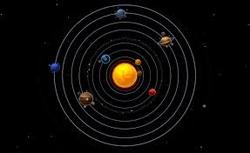Planetary mystery
Classical Mechanics
Level
2
 A planet is in circular orbit around the Sun. Its distance from the Sun is four times the average distance of Earth from the Sun. The period of this planet, in Earth years, is
A planet is in circular orbit around the Sun. Its distance from the Sun is four times the average distance of Earth from the Sun. The period of this planet, in Earth years, is
16
8
64
4
This section requires Javascript.
You are seeing this because something didn't load right. We suggest you, (a) try
refreshing the page, (b) enabling javascript if it is disabled on your browser and,
finally, (c)
loading the
non-javascript version of this page
. We're sorry about the hassle.
The planet's period is 8 Earth Years.
Actually, Kepler's Laws can be applied, because a circle is considered to be a special case of an ellipse. So, the equation is:
T = G m S 2 π a 3 / 2
where a is the length of the semi-major axis, G = 6 . 6 7 × 1 0 − 1 1 k g 2 N m 2 is the gravitational constant, and m S is the mass of the Sun.
In the case of circular orbits, however, the radius r will now be equal to the length of the semi-major axis a , that is: r = a .
T = G m S 2 π r 3 / 2
Knowing that the radius of the planet's orbit r P is 4 times the radius of Earth's orbit r E , that is: r P = 4 r E :
T E = G m S 2 π r E 2 3
T P = G m S 2 π r P 2 3 = G m S 2 π ( 4 r E ) 2 3
T P = 8 × G m S 2 π r E 2 3 = 8 T E
The planet's period is 8 times the period of the planet Earth.